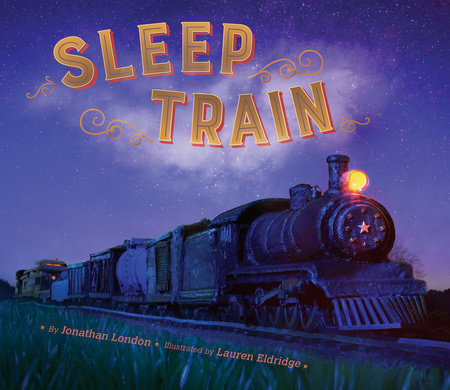Lauren Eldridge on Creating the Dreamy Art for Sleep Train
by the Brightly Editors
It’s time to add Sleep Train, a counting book written by Jonathan London and illustrated by Lauren Eldridge, to your collection of bedtime stories. Open the book and you’ll find yourself on a sunset-lit journey through the countryside, counting the ten cars of a train, from the engine in front to the caboose in back. With pictures in dreamy, subdued hues and text that’s calm and repetitive, this picture book lulls young readers to sleep with ease. In this installment of Meet the Illustrator, Lauren Eldridge takes us behind the scenes of sculpting the amazingly detailed 3D models that take center stage in Sleep Train and shares helpful tips for encouraging kids’ artistic creativity.
What first made you excited about art?
One of the wonderful things about art is that it brings creativity and problem-solving together in such a way that’s entirely personal to the artist. Even if we’re all given the same tools, materials, instructions, and amount of time, our end products will all be different! Some of the coolest parts about creating art are that no two pieces are the same, no one can be “wrong” because artistic expression is entirely subjective … plus it’s SUPER FUN!
What’s your favorite thing to create at the moment?
I absolutely LOVE to learn new techniques and, following Sleep Train, I knew I wanted to hone my puppet- and character-making skills. This meant researching how to create solid armatures that could be positioned in active ways — and stay perfectly still — for photography. Characters typically drive the storylines in picture books, so I really wanted to have a thorough understanding of how and why I would make choices about materials, texture, and movement when creating puppets in the future.
I created these characters out of wire, foam, polymer clay, pinheads, and suede. I have two young daughters and so I made the girls’ clothes from old clothes that each of my small ladies used to wear and love.



Which illustration from your latest book did you especially enjoy creating?
I really enjoyed making the scene where our main character is reading in his bedroom before it becomes the sleeper car because it tells us so much about his personality. I wanted to create a relatable character with rich interests by scattering dozens of detail-oriented hints about who he is and what he likes to do throughout the room.

If readers look closely, they’ll see the types of toys he likes to play with, activities he likes to do, and even real books he likes to read. There are also several toy train cars that look like the cars he’s about to count, as well as some other hints that suggest what is to come, too!


What is the most unusual object you used in creating Sleep Train?
I used a LOT of unusual objects but most bizarre was an empty parmesan cheese container combined with a sliced foam ball. It was the perfect diameter and material to be the base of the tanker car!

Can you make us a self-portrait?
Yes! I actually really love simple sketching based on my mood for fun and expression, even though I usually build my final illustrations.

What illustrated book have you read recently and been wowed by?
I think Windows, written by Julia Denos and illustrated by E.B. Goodale, is spectacular. Goodale did an absolutely stellar job in maneuvering dwindling daylight while incorporating vibrant colors to match the vibrant community. It’s so rare to see text and pictures line up so perfectly and this book definitely falls into that magical category.
Another book that wows me every time I read it is This Is Not a Valentine, written by Carter Higgins and illustrated by Lucy Ruth Cummins. The beautiful images in this book work so well with the perfectly worded text and the outcome is a sweet, lighthearted, loving book that we can all relate to.
Why do you think art is important for kids? What can grown-ups do to encourage kids to engage with art?
Art is fantastic for kids because it allows them to explore, take risks, make mistakes, solve problems, and express themselves in a safe and fun way! Grown-ups can help by providing a variety of materials and by asking questions rather than giving directions. For example, there’s a big difference in creative expression between a blank canvas and one with outlines that asks the artist to paint-by-numbers.
When I create with kids I ask encouraging questions such as:
How are you feeling today? What kind of things or colors could you use describe that emotion?
What are you interested in? What are some things you aren’t interested in?
What are some cool things that only you can do with these materials?
And while they’re working, it’s great to make comments like, “Wow! I never would have thought to do something that way!” and “Tell me why you chose to use ____ instead of ____ in this area.”
Kids are more likely to be creative and make what they want to make if we don’t lead them with praise about any one specific thing. For example, if I said, “Wow, I really love how you used blue for this part!” a young artist might interpret that to think that blue is good and maybe other areas of their work aren’t as good — even if that wasn’t what I intended when making the statement.
Bottom line: It’s best to let the artist be their own critic and create art for their own enjoyment, not in order to gain approval from us old folks!
What’s the best name for a color that you’ve ever heard?
Wenge. It kind of sounds how it looks … It’s a weird brown-beige-slightly orange color and whenever I see it, I think, “Well, that does seem pretty wenge-y.”

